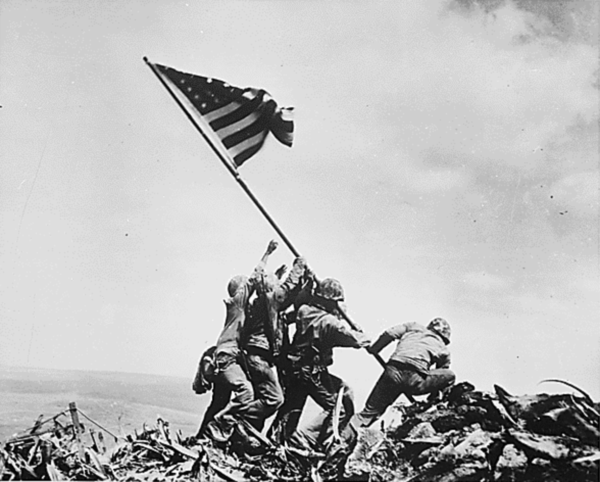
The U.S. Marine Corps celebrates its founding every November 10. (Photo: Lance Cpl. Cody A. Fodale, U.S. Marine Corps)
The U.S. Marine Corps celebrates its birthday every November 10 in honor of the founding of the Continental Marines.
THE FOUNDING OF THE U.S. MARINE CORPS
In 1775, America’s first amphibious infantry force was created to harass British naval forces during the War for Independence.
April 19, 1775: The American Revolution Begins
After years of increasing tension between the 13 American Colonies and Great Britain, the American Revolution began on April 19, 1775, when British forces attempted to seize an American weapons cache in Concord.
Colonial militiamen confronted the British troops at Lexington and later near the weapons cache itself before dispersing into the countryside to regroup. Not long after, the Siege of Boston began and the war had officially begun under the direction of the Continental Congress and General George Washington.
November 10, 1775: The Continental Marine Act is signed
Colonial leaders knew that defeating the British Navy was an unrealistic goal, but creating a small force that could harass the enemy fleet at key locations in the Atlantic could further the war effort at home.
Roughly a month after the founding of the Continental Navy (which would later become the U.S. Navy), Congress agreed that an amphibious infantry force would help the Navy accomplish this mission. As such, Congress signed the Continental Marine Act of 1775 on Nov. 10, creating two battalions of marines, which trace their roots to the Tun Tavern in Philadelphia. Captain Samuel Nicholas, a former Quaker expelled from his community for supporting the Revolution, set up a recruiting headquarters in collaboration with the tavern’s owner, marking the establishment of the Continental Marines.
From the American Revolution to Modern Warfare
In 1798, and in response to growing tensions with the French Navy and other European powers, President John Adams signed a new law formally establishing the United States Marine Corps to again act as an auxiliary force under the direction of the Navy.
The Marine Corps has since played a pivotal role in shaping American history. Emerging from the Revolutionary War, the Corps faced challenges in the quasi-war with France, battles against Barbary pirates, and active participation in the War of 1812. It saw expansion after the Spanish-American War, distinguished itself in World War I, and evolved into a force essential for amphibious warfare during World War II.
Iconic Moments and Famous Faces

On February 23, 1945, members of the 28th Regiment, 5th Division, United States Marines, raised the American flag on Mount Suribachi in Iwo Jima, Japan (Photo: U.S. National Archives)
The iconic photograph of Marines planting the American flag on Iwo Jima during World War II remains etched in history. In 2016, it was revealed that one of the identified men, Private First Class Harold Schultz, was not in the image, highlighting the importance of the photograph as a representation of the Marine Corps’ spirit rather than individual identities.
1883: “Semper Fi”
In 1883, the Marine Corps adopted the Latin phrase “Semper Fidelis” as its official motto. However, prior to that, Marines embraced three unofficial mottos: “By Sea and by Land,” “Fortitudine,” and “To the shores of Tripoli.”
“Semper Fidelis” symbolizes an eternal commitment to success, national progress, and unwavering loyalty among Marines.
1950-1991: Korean, Vietnam, and the Cold War
The Marine Corps demonstrated adaptability during the Korean War, proving the viability of amphibious assault. In Vietnam, more than 85,000 Marines served, facing significant losses.
The Corps also played crucial roles in responding to global challenges during the Cold War, from interventions in Lebanon and the Dominican Republic to maintaining a presence in NATO’s northern flank.
1989-2003: Post-Cold War Era to the War on Terror
The late 20th century and early 21st century witnessed the Marine Corps’ role in responding to global crises. Operations such as Just Cause in Panama (1989), the Gulf War (1990-1991), and humanitarian efforts in Somalia (1992) demonstrated the Marines’ versatility. The post-9/11 era saw extensive Marine involvement in Afghanistan, Iraq, and various humanitarian missions worldwide.
2003-2023: Adaptability and Resilience
The Marine Corps continued to demonstrate its adaptability and resilience in the 21st century. From the invasion of Iraq in 2003 to disaster relief operations in response to Hurricane Katrina (2005), the Marines showcased their ability to swiftly respond to diverse challenges. The Corps remains a symbol of honor, discipline, and dedication, embodying the motto “Semper Fidelis” — always faithful.
LEGACY OF THE U.S. MARINE CORPS
Today, the Marine Corps stands as a testament to its rich heritage. From the Tun Tavern to the modern era, the United States Marine Corps has exemplified valor, commitment, and adaptability. As it looks toward the future, the Corps remains a symbol of unwavering dedication to the nation, echoing the words of its official motto, “Semper Fidelis” — always faithful.
While the Continental Marines only held a minor role in the American Revolution and were disbanded shortly after the war, the groundwork they laid down during this time paved the way for the re-establishment of the Marine Corps as it is known today.
To learn about more U.S. Military and veterans holidays, click here.














Albeit late, nevertheless a heartfelt Happy Birthday to the Corp. 4th LAAM Btn 67-73. Those who returned alive during my era deserved more than to be spit on. Welcome home brothers and sisters. I pray for peace knowing who will be the first to answer the call.
Happy Marine Corps Birthday, Michael.
Rick Pushies, Marine
Long live the USMC!
Happy Marine Corps Birthday, Andy.
Rick Pushies, Marine
Happy Birthday to a great group of men……………Together a family you build to protect the families you left at home………SEMPER FI and MAY GOD BLESS AND KEEP YOU ALL SAFE AND BRING YOU ALL HOME EACH AND EVERY TIME……….
I apologize, A GREAT GROUP OF MEN AND WOMEN THESE DAYS………..MY ERA WAS ONLY MEN ALLOWED SO FORGIVE ME……..My good friend is a Major in the Marines and Im very proud of her and all she has accomplished both as a Marine and as a woman………
Happy Birthday Marines from Bill Siler iii, Navy Corpsman that was attached to the Marines 1962 – 1966 Have a good one!
My son James was in the 4th Marine division, He was assigned to “Desert Storm.” He was in the Marine Corps for 6 years. He survived the “Gulf War.”
Happy Birthday Marines
Semper Fi
Happy Marine Corps Birthday, PB.
Rick Pushies, Marine
Leatherneck for life! Happy Birthday Devil Dogs!
Happy Marine Corps Birthday, Bee.
Rick Pushies, Marine
Happy Birthday Marines
I just got back from our local MCL Marine Corps Ball.
A good time was had and a few toasts given.
Semper Fi
Happy Marine Corps Birthday, Jim.
Rick Pushies, Marine
Semper Fi
George White
Former Marine
Post 184 Executive Committee
Happy Marine Corps Birthday, George.
Rick Pushies, Marine
Happy birthday Marines
Happy Marine Corps Birthday, Falemao.
Rick Pushies, Marine
Happy Birthday Devil Dogs! 247 years of twisted steel and sex appeal! Oooo Raaahhh!
Happy Marine Corps Birthday, Stephen. “Twisted steel and sex appeal”, that is a new one for me. 🙂
Rick Pushies, Marine
From Semper Paratus to Semper Fidelis – Happy Birthday
Happy Marine Corps Birthday, Pete.
Rick Pushies, Marine
Thank COASTIE!!!
Happy 247th Marines
Happy Marine Corps Birthday, Mike.
Rick Pushies, Marine
It is true, once a Marine, always a Marine! I am Army, but I have always held a deep respect for the Marine Corps as they are a special breed of men.
LTC( R) Rios
California
Well Army, Happy Marine Corps Birthday anyway, Richard. We all too the same oath of service!
Rick Pushies, Marine
Happy 247 Birthday U.S. Marine Corps. I served in the early 1950’s with the 1st Marine division and the 3rd Marine division. My favorite day in the Corps was Nov. 10 regardless where I was in the Corps. Elwood Catalano
Happy Marine Corps Birthday, Elwood.
Rick Pushies, Marine
Proud to put USMC veteran after my name.
Happy Marine Corps Birthday, Scott.
Rick Pushies, Marine
Happy Birthday, Leathernecks!
Happy Marine Corps Birthday, Billy.
Rick Pushies, Marine
Thank you Marines for all that you do and will do when called.
Happy Birthday Marines from a USAF brother in arms.
Sincerely Frank Lett
Happy Marine Corps Birthday, Frank.
Rick Pushies, Marine
Semper Fidelis
Happy Marine Corps Birthday, Frank.
Rick Pushies, Marine
Happy Marine Corps Birthday, Frank.
Rick Pushies, Marine
Happy veteran day
Happy birthday to all Marines from an old Army veteran.
Happy Marine Corps Birthday, Dave.
Rick Pushies, Marine
A very happy birthday to America’s best fighting force Uara
Happy Marine Corps Birthday, Rosco.
Rick Pushies, Marine
Everything you are and do is greatly appreciated!
Happy Marine Corps Birthday, Louis.
Rick Pushies, Marine
I joined the Marine Corps in Feb 1971,
after ITR I was sent to Camp LeJeune for Cook School… Cook School was at Montfort Point… I suffered from esophageal cancer which was removed in 2002… My wife and I are appreciative that the President signed into law to take care of and compensate the Marines and all others who suffered illnesses from the contaminated water…
I love the Marine Corps and would do it again like I did when I was 17 yrs old in 1971…
Happy Birthday Marines, long live the Corps…
Woww1 Happy Marine Corps Birthday, Chuck.
Rick Pushies, Marine
Happy Happy Birthday, to my Brothers and Sisters of the United States Marines.
Happy Marine Corps Birthday, Donald.
Rick Pushies, Marine
Happy Birthday to all Marines of which my Uncle Henry Aleman, WWII and Raymond Aleman, Korea and my cousin Frank Benvenuti, Viet Nam and Cold War were all proud members of the U.S. Marine Corps. God bless our U.S. Marines wherever they continue to serve our great country.
Happy Marine Corps Birthday, Juan.
Rick Pushies, Marine
Sempre Fi to my Marine Brothers and Sisters.
Happy Marine Corps Birthday, Lou.
Rick Pushies, Marine
Semper Fi to all my fellow Jar Heads. Keep the spirit of the Corps with you always. You will find it inspiring when you return to your civilian life. In the interim, please know you are loved and admired by the true Americans in Our Country. OOORRRAAAHHH
Happy Marine Corps Birthday, Joseph.
Rick Pushies, Marine
Semper Fi! Happy birthday Marines! Doc John Herrera HMC (FMF) USN Retired (Senior Corpsman L/3/9 3rMarDiv RVN 66-67)
Happy Marine Corps Birthday, John.
Rick Pushies, Marine
HAPPY BIRTHDAY MARINES SEMPER FI!!
Happy Marine Corps Birthday, Sid.
Rick Pushies, Marine
Happy Birthday Fellow Marines. Semper FI
Happy Marine Corps Birthday, Brian.
Rick Pushies, Marine
We pray for the U.S.M.C. and its continued success in training and fighting.
Happy Marine Corps Birthday, Robert.
Rick Pushies, Marine
Congratulations USMC on another year of defending the United States of America ! Thank You !! Sgt James Foster USMC
Semper Fidelis & Happy Birthday. We are working on building a team of Marines in my post to dig in and help with grunt work that needs doing. I am Post 66 in San Luis Obispo that locally if call SLO. We have given our team of Marines the name SLO Marines. Just cuz Marines like to have some fun now and then. Happy Marine Corps Birthday, James.
Rick Pushies, Marine
Thanks, from an old Marine.
Happy Birthday Rick,
thanks for doing what you do.
Thanks, Jim. This is a busy time of the year, Marine Corps Birthday followed by Veterans Day. A guy could have too much fun! 🙂